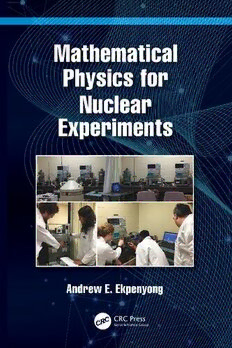Table Of ContentMathematical
Physics for Nuclear
Experiments
Mathematical
Physics for Nuclear
Experiments
Andrew E. Ekpenyong
First edition published 2022
by CRC Press
6000 Broken Sound Parkway NW, Suite 300, Boca Raton, FL 33487-2742
and by CRC Press
2 Park Square, Milton Park, Abingdon, Oxon, OX14 4RN
© 2022 Taylor & Francis Group, LLC
CRC Press is an imprint of Taylor & Francis Group, LLC
Reasonable efforts have been made to publish reliable data and information, but the author and pub-
lisher cannot assume responsibility for the validity of all materials or the consequences of their use.
The authors and publishers have attempted to trace the copyright holders of all material reproduced
in this publication and apologize to copyright holders if permission to publish in this form has not
been obtained. If any copyright material has not been acknowledged please write and let us know so
we may rectify in any future reprint.
Except as permitted under U.S. Copyright Law, no part of this book may be reprinted, reproduced,
transmitted, or utilized in any form by any electronic, mechanical, or other means, now known or
hereafter invented, including photocopying, microfilming, and recording, or in any information stor-
age or retrieval system, without written permission from the publishers.
For permission to photocopy or use material electronically from this work, access www.copyright.
com or contact the Copyright Clearance Center, Inc. (CCC), 222 Rosewood Drive, Danvers, MA
01923, 978-750-8400. For works that are not available on CCC please contact mpkbookspermis-
[email protected]
Trademark notice: Product or corporate names may be trademarks or registered trademarks and are
used only for identification and explanation without intent to infringe.
Library of Congress Cataloging-in-Publication Data
Names: Ekpenyong, Andrew E., author.
Title: Mathematical physics for nuclear experiments / Andrew E. Ekpenyong.
Description: First edition. | Boca Raton : CRC Press, 2022. | Includes
bibliographical references and index.
Identifiers: LCCN 2021020492 | ISBN 9780367768522 (hardback) | ISBN
9781032104997 (paperback) | ISBN 9781003215622 (ebook)
Subjects: LCSH: Mathematical physics. | Nuclear physics--Experiments.
Classification: LCC QC20 .E37 2022 | DDC 530.15--dc23
LC record available at https://lccn.loc.gov/2021020492
ISBN: 978-0-367-76852-2 (hbk)
ISBN: 978-1-032-10499-7 (pbk)
ISBN: 978-1-003-21562-2 (ebk)
DOI: 10.1201/9781003215622
Typeset in Latin Modern font
by KnowledgeWorks Global Ltd.
eResources are available for this title at https://www.crcpress.com/9780367768522
Dedication
I dedicate this work to Creighton University Physics Professors David
Sidebottom, Gintaras Duda, Jack Gabel, Janet Seger, Michael Cherney,
Michael Nichols, Robert Kennedy (RIP) and Sam Cipolla, who were my
teachers and now have me as a colleague.
Contents
Preface to the first edition xiii
About the Author xv
Acknowledgements xvii
Symbols xix
Chapter1■Radioactivity and Decay Law 1
1.1 THE RADIOACTIVE DECAY LAW 1
1.2 RADIOACTIVE DECAY CHAIN 7
1.2.1 The Bateman Equations 10
1.2.1.1 The System of Differential Equations 10
1.2.1.2 Laplace Transformations 10
1.2.1.3 Inverse Laplace Transformations or
Partial Fractions 11
1.3 TRANSIENT AND SECULAR EQUILIBRIA 15
1.3.1 Transient Equilibrium Applications 18
1.3.2 Matrix Exponential and Other Methods for
Bateman Equations 20
1.4 RADIOACTIVE DECAY ENERGY CALCULATIONS 21
1.5 MATHEMATICAL ELEMENTS OF ALPHA DECAY 25
1.5.1 Basics of Alpha Decay 25
1.5.2 Geiger-Nuttall Law 30
1.6 MATHEMATICAL ASPECTS OF BETA DECAY 31
1.6.1 Beta Decay Equations and Spectra 31
1.6.2 Continuous Beta Spectrum and Neutrinos 34
vii
viii ■ Contents
1.6.3 Transition Rate and Fermi-Kurie Plots 35
1.7 MATHEMATICAL PHYSICS OF GAMMA DECAY 43
1.7.1 Isomeric Transition Energetics and Multipole
Selection Rules 43
1.7.1.1 Parity, Spin and Angular Momentum
in Multipole Selection Rules 45
1.7.2 Internal Conversion Coefficients 48
1.7.3 Electron Capture versus Isomeric Transition 51
1.7.4 Auger Electrons 52
1.7.5 Coincidences and Angular Correlations 53
1.8 SPONTANEOUS FISSION 55
1.9 ANSWERS 56
Chapter2■Probability and Statistics for Nuclear Experimental
Data 61
2.1 PROBABILITY DISTRIBUTIONS AND THEIR
CHARACTERISTICS 61
2.1.1 Cumulative Distribution 62
2.1.2 Expectation Values, Mean, Variance and
Covariance 63
2.2 BINOMIAL DISTRIBUTION 66
2.3 POISSON DISTRIBUTION 69
2.4 GAUSSIAN OR NORMAL DISTRIBUTION 78
2.5 MAXWELLIAN DISTRIBUTION 82
2.6 CHI-SQUARE DISTRIBUTION 82
2.7 EXPONENTIAL DISTRIBUTION 86
2.8 LANDAU AND OTHER DISTRIBUTIONS 87
2.9 DETERMINATION AND TESTS OF PROBABILITY
DISTRIBUTIONS 90
2.9.1 Estimation of Mean, Variance and Covariance
from Samples 90
2.9.2 Using Relative Frequency for Sample Mean and
Variance 92
Contents ■ ix
2.9.3 Chi-Square Test and other Statistical Tests on
Experimental Data 93
2.10 UNCERTAINTIES: CALCULATION AND EXPRESSION 97
2.10.1 Accuracy and Precision, Error and Uncertainty 97
2.10.2 Statistical and Systematic Uncertainties 99
2.10.2.1 Statistical or Random Uncertainties 99
2.10.2.2 Systematic Uncertainties 99
2.10.3 Calculation, Estimation and Expression of
Uncertainties 100
2.11 ERROR PROPAGATION 100
2.11.1 Error Propagation Formula 100
2.11.2 Examples of Error Propagation 103
2.12 ANSWERS 108
Chapter3■Energy Loss of Heavy Charged Particles through
Matter 111
3.1 GENERAL RESULTS AND PERTURBATION THEORY 111
3.2 BOHR’S CLASSICAL FORMULA 116
3.2.1 Terminology and Physical Basis 116
3.2.2 Classical Derivation 117
3.3 BETHE’S QUANTUM MECHANICAL FORMULA 121
3.3.1 Derivation of Differential Cross Section 121
3.3.2 Validity Conditions and Relativistic Corrections 124
3.4 BLOCH AND OTHER EXTENSIONS OF BETHE’S
FORMULA 127
3.4.1 Summary of Corrections and Extensions 127
3.4.2 Bloch’sCorrectionandExtensions:Mathematical 128
3.5 RANGE OF HEAVY CHARGED PARTICLES 136
3.6 MEDICAL APPLICATIONS OF BRAGG PEAK 140
3.7 IDENTIFICATION OF PARTICLES AND OTHER
APPLICATIONS 142
3.8 PSTAR, ASTAR AND OTHER SOFTWARE PACKAGES 146

